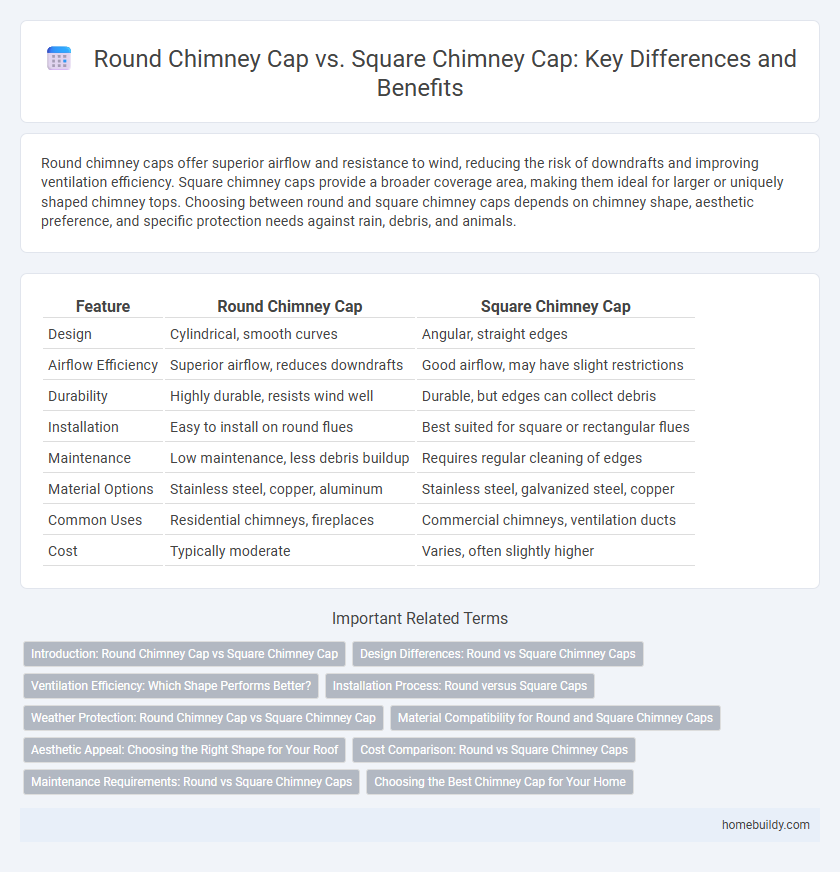Round chimney caps offer superior airflow and resistance to wind, reducing the risk of downdrafts and improving ventilation efficiency. Square chimney caps provide a broader coverage area, making them ideal for larger or uniquely shaped chimney tops. Choosing between round and square chimney caps depends on chimney shape, aesthetic preference, and specific protection needs against rain, debris, and animals.
Table of Comparison
| Feature | Round Chimney Cap | Square Chimney Cap |
|---|---|---|
| Design | Cylindrical, smooth curves | Angular, straight edges |
| Airflow Efficiency | Superior airflow, reduces downdrafts | Good airflow, may have slight restrictions |
| Durability | Highly durable, resists wind well | Durable, but edges can collect debris |
| Installation | Easy to install on round flues | Best suited for square or rectangular flues |
| Maintenance | Low maintenance, less debris buildup | Requires regular cleaning of edges |
| Material Options | Stainless steel, copper, aluminum | Stainless steel, galvanized steel, copper |
| Common Uses | Residential chimneys, fireplaces | Commercial chimneys, ventilation ducts |
| Cost | Typically moderate | Varies, often slightly higher |
Introduction: Round Chimney Cap vs Square Chimney Cap
Round chimney caps offer superior wind resistance and improved draft efficiency due to their aerodynamic shape, making them ideal for areas with strong winds. Square chimney caps provide a larger coverage area, which is beneficial for wider chimney flues and enhanced rain protection. Choosing between a round or square chimney cap depends on the specific chimney dimensions and local weather conditions to optimize performance and durability.
Design Differences: Round vs Square Chimney Caps
Round chimney caps offer a streamlined, aerodynamic design that effectively reduces wind resistance and prevents downdrafts, while their curved shape facilitates better water runoff, minimizing rust and corrosion. Square chimney caps provide a more traditional, angular aesthetic that can complement classic architectural styles and offer increased internal volume for improved ventilation. Both designs vary in material compatibility and installation methods, influencing durability and maintenance requirements based on specific roof types and chimney structures.
Ventilation Efficiency: Which Shape Performs Better?
Round chimney caps generally provide superior ventilation efficiency due to their streamlined shape, which promotes better airflow and reduces turbulence. Square chimney caps can sometimes obstruct airflow at corners, creating pockets where smoke and gases may accumulate. Optimal ventilation depends on the specific chimney design, but round caps typically enhance draft performance and prevent downdrafts more effectively than square caps.
Installation Process: Round versus Square Caps
Round chimney caps generally offer a simpler installation process due to their uniform shape, allowing for easier fitting onto round flue pipes without the need for additional sealing or adjustments. Square chimney caps often require more precise alignment and custom fitting to square flue openings, potentially involving extra steps like sealing corners and ensuring watertight edges. Choosing between round and square chimney caps impacts installation time and complexity, with round caps typically preferred for quicker, more straightforward setup on standard round chimneys.
Weather Protection: Round Chimney Cap vs Square Chimney Cap
Round chimney caps provide superior weather protection due to their aerodynamic shape, which effectively deflects wind and prevents rainwater from entering the flue. Square chimney caps, while easier to install and often more traditional in appearance, may allow more water intrusion during heavy storms because their flat surfaces can accumulate and channel rainwater. Choosing a round chimney cap enhances durability and minimizes moisture-related damage in regions with frequent strong winds and precipitation.
Material Compatibility for Round and Square Chimney Caps
Round chimney caps are typically crafted from materials such as stainless steel, copper, and galvanized steel, ensuring excellent compatibility with round flue liners and metal chimneys by providing a snug fit and preventing moisture infiltration. Square chimney caps often utilize similar materials but are designed to accommodate square or rectangular chimneys, with attention to sealing flat surfaces to avoid water penetration and resist wind-driven rain. Material compatibility in both round and square chimney caps is crucial for durability and effective protection, with stainless steel offering superior corrosion resistance across both shapes.
Aesthetic Appeal: Choosing the Right Shape for Your Roof
Round chimney caps offer a sleek, aerodynamic silhouette that complements modern and traditional rooflines, enhancing overall curb appeal. Square chimney caps provide a bolder, more structured appearance, ideal for homes with angular architectural features and gabled roofs. Selecting the right shape aligns the chimney cap with your roof's design, balancing function with aesthetic harmony.
Cost Comparison: Round vs Square Chimney Caps
Round chimney caps typically cost between $50 and $150, offering a more aerodynamic design that enhances durability and wind resistance. Square chimney caps usually range from $70 to $200, providing a larger coverage area but requiring more material, which increases the price. Installation expenses for both styles vary based on size and material, but square caps often incur slightly higher labor costs due to their shape and complexity.
Maintenance Requirements: Round vs Square Chimney Caps
Round chimney caps generally require less maintenance due to their streamlined shape, which reduces debris buildup and allows rainwater to flow off easily. Square chimney caps tend to accumulate more leaves and dirt in their corners, necessitating more frequent cleaning to prevent blockages and corrosion. Proper maintenance of either shape prolongs the chimney cap's lifespan and enhances its protective function.
Choosing the Best Chimney Cap for Your Home
Round chimney caps offer superior resistance to strong winds and prevent downdrafts more effectively, making them ideal for homes in windy areas. Square chimney caps provide greater coverage and are often easier to install on traditional masonry chimneys with square flue openings. Selecting the best chimney cap depends on your chimney's shape, local weather conditions, and the specific protection required against rain, debris, and animals.
Round chimney cap vs Square chimney cap Infographic

 homebuildy.com
homebuildy.com